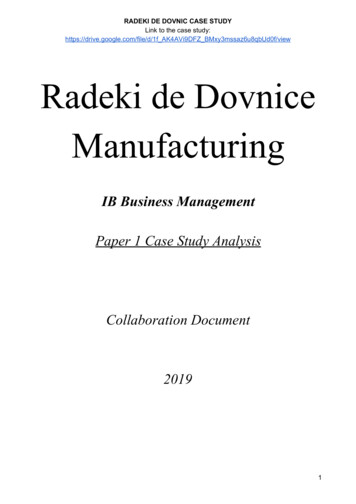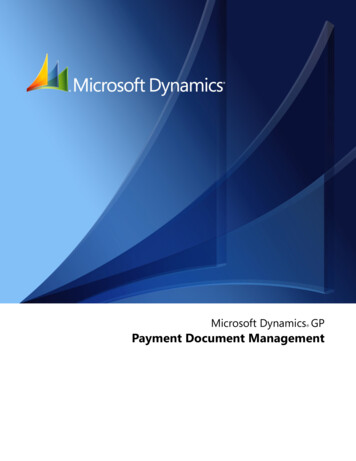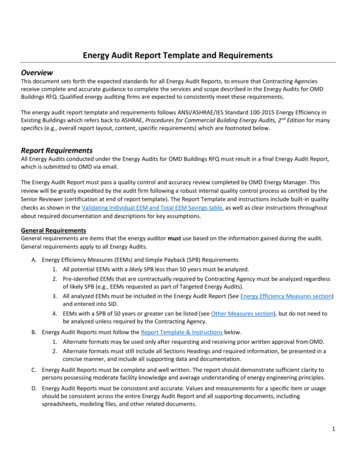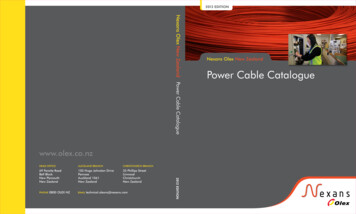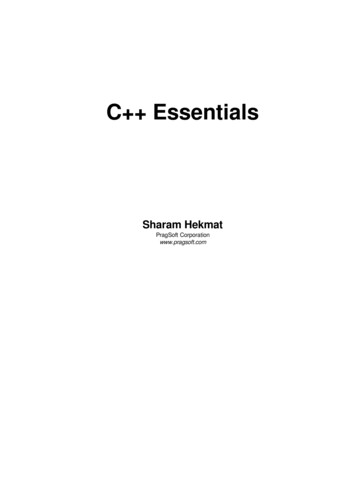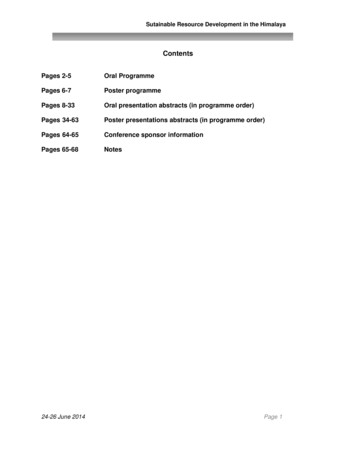
Transcription
Sutainable Resource Development in the HimalayaContentsPages 2-5Oral ProgrammePages 6-7Poster programmePages 8-33Oral presentation abstracts (in programme order)Pages 34-63Poster presentations abstracts (in programme order)Pages 64-65Conference sponsor informationPages 65-68Notes24-26 June 2014Page 1
Sutainable Resource Development in the HimalayaOral ProgrammeTuesday 24 June 201409.00Welcome11.30Student presentation from Leh School11.45A life in LadakhProfessor (ambassador) Phunchok Stobdan, Institute for Defence Studies andAnalysesLunch and posters12.3014.00Mountaineering in the HimalayaAng Rita Sherpa, Mountain Institute, Kathmandu, NepalSession theme: The geological framework of the Himalaya14.3015.15Geochemical and isotopic constraints on magmatic rocks – someconstraints on collision based on new SHRIMP dataProfessor Talat Ahmed, University of KashmirShort subject presentations and panel discussionModerators: Director, Geology & Mining, Jammu & Kashmir State &Director, Geological Survey of IndiaStructural framework of the Himalayas with emphasis on balanced crosssectionsProfessor Dilip Mukhopadhyay, IIT RoorkeeSedimentologyProfessor S. K. Tandon, Delhi UniversityPetrogenesis and economic potential of the Early Permian Panjal Traps,Kashmir, IndiaMr Greg Shellnut, National Taiwan Normal UniversityPrecambrianProfessor D. M. Banerjee, Delhi University16.0016.40Tea and postersShort subject presentations continued & panel discussion18.00Close of day24-26 June 2014Page 2
Sutainable Resource Development in the HimalayaWednesday 25 June 2014Session theme: Climate, Landscape Evolution & Environment09.00ClimateProfessor Harjeet Singh, JNU, New DelhiEarth surface processes and landscape evolution in the Himalaya09.30Professor Lewis Owen, Cincinnati University10.0010.3011.10Landscape & VegetationDr P. P. Dhyani, GB Pant Institute of Himalayan DevelopmentTea and postersShort subject presentations and panel discussionModerator: Commissioner of Forests and Environment, Jammu & KashmirStateBiodiversity, species patterns, habitat relationships and land use status ofhigh altitude rangelands and their interfaces in upper Bhaderwah valley(north-western Himalayas), Jammu and Kashmir, IndiaDr Neeraj Sharma, Institute of Mountain Environment, University of JammuConservation & Development Challenges in the HimalayaDr Sejal Worah, WWF-IndiaEmpowering Ladakhi WomenThinlas Chorol, Ladakhi Women's Travel Company12.50Lunch and postersSession theme: Sustainable Resources14.00Water and SanitationHRH Prince El Hassan Bin Talal, Chair of UN Secretary General’s AdvisoryBoard on Water and SanitationWater Resilience to Climate Change and Human Development14.30Dr Mohammad Shamsudduha, IRDR-UCL15.0015.3016.10Engineering challenges for development in mountainous areasDr Gareth Hearn, Hearn Geoserve LtdTea and postersShort subject presentations & panel discussionModerator: Commissioner Planning/PHE, Jammu & Kashmir StateMarkets, Institutions & Regulatory Regimes for a Market for Water in RuralNorth West IndiaProfessor Dipankar Sengupta, University of JammuAgriculture and Food ProductionProfessor Tej Partap Singh, SKUASTGeothermal Energy-Tapping the Heat from BelowProfessor Joe Moore, EGI University of Utah18.00Social AspectsProfessor Lobzang Tsewang/Professor Chewang Norphal, LadakhClose of day24-26 June 2014Page 3
Sutainable Resource Development in the HimalayaThursday 26 June 2014Session theme: Natural Hazards and Risks08.30Earthquake Hazard in Himalayan Region: How to Mitigate?Professor Harsh Gupta, Geological Society of IndiaActive Deformation and Seismic Hazard in the India-Asia collision zone09.00Dr Tim Wright, Leeds University09.30Short subject presentations and panel discussionModerator: Commissioner Revenue, Jammu & Kashmir StateSeismic Hazard Assessment in India: Current status and future plansDr B. K. Bansal, Indian Ministry of Earth SciencestbcProfessor T. N. Singh, IIT MumbaiTraversing Disciplinary Borders: Greening Social Development throughInterdisciplinary Approaches – Lessons for the Himalayas?Professor Lena Dominelli, Durham UniversityThe role of science and scientists in earthquake risk reductionDr Susanne Sargeant, British Geological Survey10.3011.1012.30Tea and postersSubject presentations continued and panel discussionLunch and postersSession theme: Tourism Opportunities and Challenges – (Mountain, Heritage,Cultural and Sensitive Environments)Chairs: Commissioner Tourism, Jammu & Kashmir State; Professor Parikshat SinghManhas, University of Jammu & Mr Rattan Kotwal, former Commonwealth TourismAdvisor & Deputy Director General Tourism Government of IndiaA Sustainable Mystic Avenue to Wellness in Himalayan regions: Linking14.00ecological and economic concernsProfessor Parikshat Singh Manhas, University of JammuMarketing the MountainsMr Rattan Kotwal, Consultant, former Commonwealth Tourism Advisor & DeputyDirector General Tourism Government of IndiaTourism Impacts of Anthropogenic Geomorphologic Changes Caused byEnvironmental Disasters in the Carpathian Mountains and BasinProfessor David Lorant, Szent István University & Jean Monnet Professor,European CommissionThe Great Himalaya TrailMr Samir Thappa, Silver Mountain School of Hotel ManagementHimalayan Resources: Opportunities & Challenges. A Preliminary Study ifResources Usage & Expected Environmental Impact in Neelum ValleyDr Mohsin Shakil, Azad Jammu Kashmir Medical College24-26 June 2014Page 4
Sutainable Resource Development in the HimalayaSession theme: Tourism Opportunities and Challenges – (Mountain, Heritage,Cultural and Sensitive Environments)Conceptualising Carbon Footprint and Offset Measures for Rural TourismDestinationsProfessor Vikneswaran Nair, Taylor’s University, MalaysiaDeveloping Sustainable Tourism in AJK: Opportunities and ChallengesDr Shaheen Akhtar, Research & Policy AnalystIssues in Preservation of Cultural Heritage in recently mapped area ofNeelum Valley (Valley of Kishen Ganga) in lower Himalayan RangeMs Rukhsana Khan, University of AJK, India15.30Tea and posters16.10Short subject presentations & panel discussionModerators: Dr Ahmed Shamsul Huda, Ghulam Ishaq Khan Institute ofScience & Technology; Dr Imtiaz Hussain, University of Poonch; JonathanCohen, Conciliations Resources; Tahir Aziz, Conciliations Resources;Ameya Kilara, Conciliations Resource & Professor Phil Meredith, UCL18.00Killing The Goose The Lays The Golden Eggs: The Impacts of EagleFeeding Activities on Kilim River Basin, Langkawi, MalaysiaProfessor Badaruddin Mohamed, Universiti Sains MalaysiaClosing ceremony, conference dinner & cultural programme24-26 June 2014Page 5
Sutainable Resource Development in the HimalayaPoster ProgrammeSeabuckthorn- next generation eco friendly crop for the fragile Himalayan ecosystemAmjad Ali, Govt. Degree College KargilFossil Elephants of the North-West HimalayaJonathan Craig, EniFoundations: D.N. Wadia and his links with the Geology Department at the University ofJammu.Beth Craig-Geen, Guildford High SchoolReviewing and visualising natural hazard interactions to inform hazard mitigation andmanagement priorities in the HimalayaJoel Gill, King’s College LondonUnconventional and Conventional Petroleum Systems in the NW Himalayan Frontal FoldThrust Belt, Riasi, IndiaNaveen Hakhoo, University of JammuOutline of Temperature Structures in Himalayan Collisional Zone: A ReviewIsmail Hossain, University of RajshadiRecent Geological Hazard in Leh – A timely warningSumeet Khullar, University of JammuFrom Fossil Fuel to Manual Energy: The Windup GirlAmbish Malik, University of JammuWind Energy Development in India: with special reference to Maharashtra StateSunil Narwade, Dr. Babasaheb Ambedkar Marathwada UniversityStudies on the analysis of cold arid soils of Lamayuru (moonland), Ladakh and itsmycodiversity.Skarma Nonzom, University of JammuClimate change - Health of human and natural systems in HimalayaStéphanie Piffeteau, Instiute of Environmental Sciences, GenevaFluctuating shorelines of Pangonng Tso Lake during HoloceneHari Singh Saini, Geological Survey of IndiaGeographer Planner’s Role towards Sustainable and Safer Tourism OppuritunitiesGurpreet Singh Sandhu, HRA InternationalEarthquakes without Frontiers: A Partnership for Increasing Resilence to Seismic Hazardin the Continents (2012-2017)Susanne Sargeant, British Geological Survey24-26 June 2014Page 6
Sutainable Resource Development in the HimalayaPoster Programme (continued)Composition, distribution, diversity, indigenous uses and conservation status ofthreatened medicinal and aromatic plants of upper Bhaderwah valley, Jammu andKashmir, IndiaNeeraj Sharma, Institute of Mountain EnvironmentThoreau and Aesthetics of natureSundus Quyoom Sheikh, University of JammuHydrocarbon Potential of Lower Palaeozoic Tethys Himalaya, IndiaHareshwar Sinha, Vinoba Bhave UniversityTourism Influx: Environment, Socio-Economic and Cultural Dynamics of Ladakh RegionChhering Tandup, University of Jammu24-26 June 2014Page 7
Sutainable Resource Development in the HimalayaORAL PRESENTIATONS (Programme order)Mountaineering in the HimalayaAng Rita SherpaMountain Institute, KathmanduEach year more than 36,000 tourists, a number approximately ten times the local population,visit the Khumbu region of Sagarmatha National Park as trekkers and mountaineers. Thesevisitors bring with them more than 80,000 people as back up staff, adding to the large totalpopulation. Mountaineers and trekkers come to enjoy spectacular mountain scenery, diverseand unique flora and fauna, as well as the Sherpa culture unique to this remote area. Whilerepresenting an important economic opportunity for these communities, they also place a heavyburden on the ecology of the region as well as disruptive influences on the local culture.Tourism has greatly benefited the Sherpas of Khumbu by providing them with the opportunity towork as guides and porters. Many Sherpa of Khumbu work exclusively for mountain expeditions,a prestigious and well paying occupation. By providing locals with these jobs, their standard ofliving is often improved.Despite widespread improvements in the villagers’ living conditions, there is still great disparity inthe distribution of tourism’s benefits among various socio-economic groups of the region. Thebenefits of trekking-based tourism are not distributed equally throughout the park and manyareas remain culturally and economically isolated and underdeveloped.To mitigate these issues the Mountain Institute (TMI) began implementing programs to ensuresustainable management of tourism in the area by introducing an innovative form of tourismknown as Community-Based Tourism (CBT). TMI helped to establish a project called “SacredSites Trail to Khumbu” in the Khumbu region of Nepal, bringing trekkers to less visited villages inthe area. This article will provide an outline of the growth of tourism and highlight the economicopportunities which the project aims to address, the principles on which it is based, and some ofits achievements.24-26 June 2014Page 8
Sutainable Resource Development in the HimalayaGeochemical and isotopic constraints on magmatic rocks- some constraints on collisionbased on new SHRIMP dataTalat AhmadDepartment of Geology, University of Delhi, Delhi – 11 00 07, IndiaPresently VC Jamia Millia Islamia, New Delhi-11 0025, IndiaThe Indus-Tsangpo Suture Zone (ITSZ) is considered to represent collision zone between theIndian and Eurasian plates, preserving parts of the Neo-Tethyan Ocean. This collision event isconsidered to be marked by (1) transition from marine to continental sedimentation in the ITSZ,(2) termination of I-Type granite magmatism in the Trans-Himalayan Gangdese Batholith, (3)initiation and emplacement of S-Type anatectic granitoids and migmatites and (4) thedevelopment of south-verging thrust and folds in the Tibetan–Tethys and Indus–Tsangpo SutureZone. I-type granite in a subduction zone is expected to follow calc-alkaline trend and S-typegranite magmatism is expected to have formed in a thickened crustal environment because ofaccumulation of radioactive minerals and extensional environment. Geochemical and isotopic(Sr and Nd) data for the magmatic rocks of the Indus and Shyok sutures reveal importantcontrasts. The volcanic rocks of the Indus and Shyok suture zones are sub-alkaline basalt,basaltic-andesite, andesite and rhyolite.The Indus suture rocks have nearly flat to slightly depleted light rare earth and large ionlithophile element (LREE-LILE) characteristics, with strong negative anomalies for the high fieldstrength element (HFSE: Nb, P and Ti). These incompatible elemental characteristics indicatethat they probably represent intra-oceanic island arc setting. Shyok suture rocks, on the otherhand, have enriched LREE and LILE respectively and depleted HFSE trace elementcharacteristics. They probably represent ocean-continent island arc system.In addition to the arc component, the Indus suture contain the Zildat ophiolitic mélange withdominant OIB characteristics as evidenced by highly enriched Nb (60 to 130 ppm) and stronglynegative values for fSm/Nd (-0.4147 to -0.4676) relative to CHUR. However, these rocks havepositive epsilon Ndt 110 Ma of about 3 and 4, like many OIBs, indicating their derivation formisotopically depleted sources that got elementally enriched prior to melting. A minor componentof this mélange is characterized by depleted LILE-LREE, highly positive epsilon Ndt 110 Ma ofabout 9 and initial Sr of 0.70466 to 0.70666, seen in many N-MORBs. The arc component,represented by the Nidar ophiolitic complex, have higher abundances of the LREE-LILE withrespect to N-MORB and positive epsilon Ndt 110 Ma of about 8 and 9, similar to Zildatmélange. Initial Sr values for Nidar gabbros vary between 0.70422 and 0.70546 indicatingabsence of continental crustal component.Shyok volcanics and Nubra ophiolitic volcanics of the Shyok suture zone have epsilon Ndt 110Ma of about 5 to -2, fSm/Nd of
Conceptualising Carbon Footprint and Offset Measures for Rural Tourism Destinations Professor Vikneswaran Nair, Taylor’s University, Malaysia Developing Sustainable Tourism in AJK: Opportunities and Challenges Dr Shaheen Akhtar, Research & Policy Analyst Issues in Preservation of Cultural Heritage in recently mapped area of
